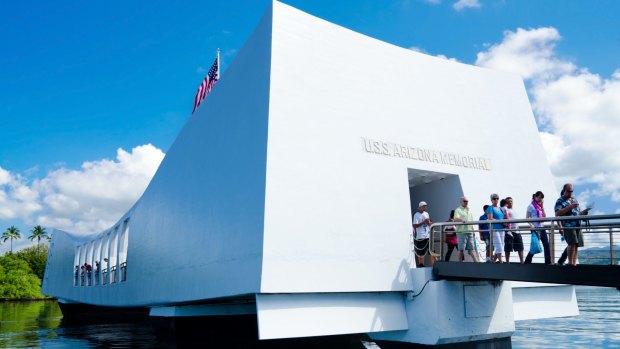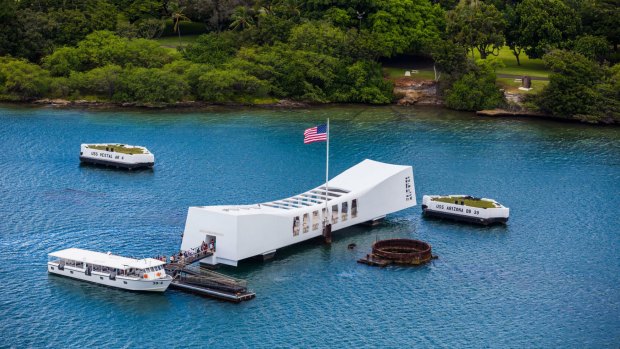This was published 4 years ago
Pearl Harbor, Hawaii: What other nations could learn from this quiet harbor
By Mark Chipperfield

Visitors walking out from the USS Arizona Memorial.Credit: iStock
"I'd suggest visiting Pearl Harbor on your last day in Hawaii," says an American friend on O'ahu. "The experience is so powerful, it'll knock you sideways."
Just 30 minutes from the picture postcard beaches of Waikiki, Pearl Harbor is indeed the antithesis of the carefree, innocent pleasures we associate with Hawaii.
Apart from being a compelling historic site, Pearl Harbor is for Americans a quasi-religious shrine – a place that galvanizes the patriotic spirit of a nation and remains a focus for intense, heart-felt mourning.

Pearl Harbor. Credit: Hawaii Tourism Authority
President Franklin D. Roosevelt famously called December 7, 1941 and the Japanese bombing of Pearl Harbor "a date that will live in infamy".
Even with the passage of time that sense of outrage and shock remains palpable.
"Pearl Harbor is still within the collective memory of Hawaii," says my guide Eugene. "That's the thing about Hawaii – as Polynesians we have a strong oral history tradition. As long as the harbour is here, we will always have that connection with the events of December 1941."
While Pearl Harbor has a strong emotional pull for Americans, Eugene, who works for E Noa Tours, is pleased that the site is now attracting so many young people from around the world, including Japan, who are taught little, if anything about Pearl Harbor in the school room.
"This has become a place of reconciliation," he says.
An estimated 1.5 million people visit Pearl Harbor each year to explore the national museum, climb inside the USS Bowfin, a wartime sub, tour the Battleship Mississippi and stand on a pontoon which floats above the wreck of the USS Arizona – a watery tomb for the 1177 sailors who lost their lives when the ship was blown apart by a Japanese torpedo on that fateful Sunday morning.
"During the war, Americans were exhorted to 'Remember the Arizona, Remember Hawaii'. It was a rallying cry for the whole nation," says Eugene, a retired architect.
During 2020 there will be a number of special tributes, commemorations and banquets at Pearl Harbor to mark the 75th anniversary of the end of the War in the Pacific, a conflict that cost the lives of 106,000 US military personnel and 2.1 million Japanese sailors, soldiers and airmen, along with an estimated 20 million civilians.
In August and September, Oahu will host a series of fly-pasts, receptions and dinners to honour those who lost their lives at Pearl Harbour when Japan launched its surprise aerial attack on the base, sinking five American battleships and badly damaging 16 other vessels.
"At the time, the American people were expecting a war with Japan," says Eugene. "But no-one thought it would start here – and certainly not in the way it unfolded."
The commemorations will culminate in a formal banquet for veterans on board the Battleship Missouri. Now moored at Pearl Harbor, the "Mighty Mo" hosted the formal surrender by Japanese forces to General Douglas Macarthur on September 2, 1945, thus ending the war.
A brass plaque on the battleship's deck marks the exact spot where the surrender document was signed. The elaborate ceremony, watched by hundreds of sailors sitting on the upper decks and guns, was brilliantly stage-managed by Macarthur who deliberately kept the Japanese delegation waiting– and placed two emaciated officers, recently released from a POW camp, behind him.
At the conclusion of the ceremony MacArthur made a famous radio address to his countrymen. Seven decades later, his words still bristles with pride, defiance and loss.
"Today the guns are silent," he intoned. "The skies no longer rain death and the seas only bear commerce. Men everywhere walk upright in the sunlight. The entire world is quietly at peace. The holy mission has been completed."
Built in 1944, this floating behemoth measures 270.4 metres in length, weighs 46,000 tons and can carry a crew of 2534. Its giant 16.5-inch guns could fire an armour-piercing missile 37 kilometres with pinpoint accuracy.
The Iowa-class battleship, which also saw service in the Korean and the first Gulf War, remains an impressive sight and will prove spell-binding to anyone with an interest in naval history; below its vast decks lies a catacomb of mess halls, sleeping quarters, medical facilities, radio rooms, officer's quarters and a fully equipped bakery.
While Americans retain a special affection for the Mighty Mo, admirably maintained by an army of volunteers, nothing exerts such a strong emotional pull as the wreck of the USS Arizona, a mass grave lying just 12 metres below the placid waves of Pearl Harbor.
Standing on the floating memorial, an austere white buoy of grief and remembrance, visitors stare down at the opaque outline of the broken ship. Heavy oil from the Arizona's fuel tanks bubbles to the surface (and is expected to keep bubbling for the next 50 years), like some mysterious communication from the dead.
Elsewhere we stand in front of a simple honour board bearing the names of the 1177 crewmen who died on December 7, 1941. Only 355 sailors escaped the burning ship and many choose this as their final resting place – a ritual performed by specially trained navy divers.
"A visitor once asked me to nominate the one thing that most people miss about this site," says the on-site guide Caitlin. "Well, that's pretty simple. They overlook the fact that this is a memorial."
The story of the USS Arizona is particularly tragic because the ship had been scheduled to undergo a refit on the mainland. A collision during routine exercises off Hawaii had kept her in Pearl Harbor for running repairs.
"The Arizona is kinda unusual because she wasn't even supposed to be in Hawaii at that time and yet she's become the preeminent symbol of Pearl Harbor," says Eugene. "She was going to leave here the following day, which is why her fuel tanks were full and her crew had been denied shore leave."
Like many nations, the United States is still coming to grips with its wartime legacy. Contemporary historians are starting to question the standard version of events. Why did the US navy ignore intelligence of an impending Japanese attack? Why did Admiral Yamamoto, the Japanese naval commander, spare the US aircraft carriers?
"We don't know the whole story of Pearl Harbour yet," says Eugene, who has been leading tours to the military base for eight years. "Yamamoto was a big gambler and a master tactician, but the attack on Pearl Harbor failed to knock the American Pacific fleet out of the war. We quickly turned things around and went on the offensive."
Eugene, whose grandparents lived through those dark days, sees Pearl Harbor as America's version of Dunkirk – a heroic defeat that changed the course of history.
As a memorial, Pearl Harbor is not without its faults. Some of the displays are clumsy and the sentiments jingoistic. The site itself is quite disjointed. But few other places capture America's unique sense of optimism and genuine respect for its veterans, living and past. Other nations could learn much from the quiet dignity of Pearl Harbor.
FIVE MORE HISTORIC SITES ON O'AHU
THE NATIONAL MEMORIAL CEMETERY OF THE PACIFIC
One of Hawaii's most curious military sites, this cemetery is located inside an extinct volcanic crater. The lawn cemetery, a short drive from downtown Honolulu, contains the ashes of military personnel killed during the Japanese attack on Pearl Harbor, and other conflicts.
US ARMY MUSEUM OF HAWAII
Located behind Waikiki's Fort DeRussy Beach this site was once part of O'ahu's 20th Century naval defence system. Battery Randolph was a key component of a "Ring of Steel" protecting the island but today provides an overview of the Hawaii's colourful military history.
PEARL HARBOR AVIATION MUSEUM
A short bus ride from the Pearl Harbor Visitor Centre this sprawling museum contains an astonishing collection of historic aircraft, including a Boeing Flying Fortress, a Russian MIG fighter and a Japanese Zero. The distinctive control tower has featured in many Hollywood movies.
IOLANI PALACE
Built in 1882 by King Kalakaua, this pompous building was once the home of the Hawaiian royal family. Modelled on the great royal houses of Europe, Iolani Palace contains grandiose public spaces and opulent bedrooms. After the monarchy was overthrown in 1893, the palace was stripped of its lavish furnishings but has now been fully restored. Guided tours are available.
ALI'IOLANI HALE
Designed by Australian architect Thomas Rowe in the Italian Renaissance Revival style, this former royal palace has been a landmark in Honolulu since 1874. Today the grandiose building houses the Hawaii State Supreme Court and King Kamehameha V Judiciary History Center.
THE DETAILS
FLY
Hawaiian Airlines and Qantas fly nonstop from Sydney or Brisbane to Honolulu, or via Sydney, Brisbane or Auckland from Melbourne. See qantas.com; hawaiianairlines.com.au
TOUR
Joining a small group tour is the most rewarding way to experience Pearl Harbor. E Noa is an established company offering a number of guided tours to this important World War 2 site. Choose from full- or half-day tours. Pearl Harbor Remembered ($US97 adult, US$77 child under-12) provides access to the Pearl Harbor National Museum, USS Arizona and the Battleship Missouri, plus expert commentary. Remember to leave all your bags at the hotel and observe the dress code. See enoa.com
MORE
Mark Chipperfield travelled at his own expense.
Sign up for the Traveller Deals newsletter
Get exclusive travel deals delivered straight to your inbox. Sign up now.